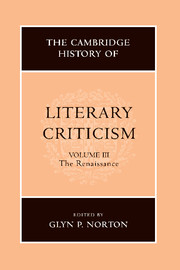Book contents
- Frontmatter
- Introduction
- READING AND INTERPRETATION: AN EMERGING DISCOURSE OF POETICS
- POETICS
- THEORIES OF PROSE FICTION
- CONTEXTS OF CRITICISM: METROPOLITAN CULTURE AND SOCIO-LITERARY ENVIRONMENTS
- VOICES OF DISSENT
- 40 The Ciceronian controversy
- 41 Reorganizing the encyclopaedia: Vives and Ramus on Aristotle and the scholastics
- 42 The rise of the vernaculars
- 43 Ancients and Moderns: France
- 44 Women as auctores in early modern Europe
- STRUCTURES OF THOUGHT
- NEOCLASSICAL ISSUES: BEAUTY, JUDGEMENT, PERSUASION, POLEMICS
- A SURVEY OF NATIONAL DEVELOPMENTS
- Bibliography
- Index
- References
40 - The Ciceronian controversy
from VOICES OF DISSENT
Published online by Cambridge University Press: 28 March 2008
- Frontmatter
- Introduction
- READING AND INTERPRETATION: AN EMERGING DISCOURSE OF POETICS
- POETICS
- THEORIES OF PROSE FICTION
- CONTEXTS OF CRITICISM: METROPOLITAN CULTURE AND SOCIO-LITERARY ENVIRONMENTS
- VOICES OF DISSENT
- 40 The Ciceronian controversy
- 41 Reorganizing the encyclopaedia: Vives and Ramus on Aristotle and the scholastics
- 42 The rise of the vernaculars
- 43 Ancients and Moderns: France
- 44 Women as auctores in early modern Europe
- STRUCTURES OF THOUGHT
- NEOCLASSICAL ISSUES: BEAUTY, JUDGEMENT, PERSUASION, POLEMICS
- A SURVEY OF NATIONAL DEVELOPMENTS
- Bibliography
- Index
- References
Summary
The Ciceronian controversy in the Renaissance was primarily a battle over Latin because only Latin authors could in a strict sense imitate Cicero. That is why even though the Ciceronians and their critics quarreled over style, the deepest fault-line separating the two sides was not an issue of style, but of language. As Horace observed (Ars poetica 71–2) – and Renaissance theorists universally acknowledged – language constantly changes and it is usus [current usage] that determines the norma loquendi [linguistic standard]. But Latin in the Renaissance was a dead language. It had long lost its community of native speakers and could only be learned at school from books. Consequently, underlying the Renaissance debates over Ciceronianism lay the question of what properly constituted usus for a dead language.
One might argue that Latin was really not a dead language since it had remained in use throughout the Middle Ages. However, medieval Latin, for all its differences with classical Latin, was no more dead or alive than the neoclassical Latin of the humanists. It too was a language without a native-speaking community, learned from books, and generally immune to the evolution experienced by the living, vernacular tongues.
Petrarch, the first great humanist, grasped the difference between the Latin of his own time and that of antiquity. But his ideas on the history of Latin were fuzzy. He idolized Cicero as the supreme embodiment of classical Latin eloquence. Yet his own Latin was still burdened with medievalisms and smacked more of Seneca than of Cicero.
- Type
- Chapter
- Information
- The Cambridge History of Literary Criticism , pp. 393 - 401Publisher: Cambridge University PressPrint publication year: 1999



